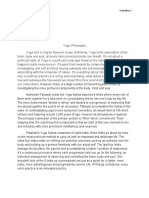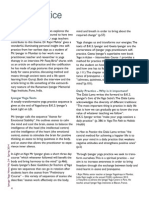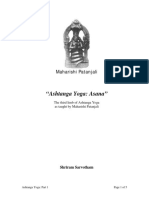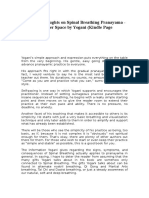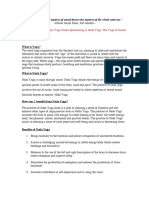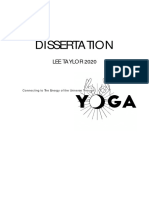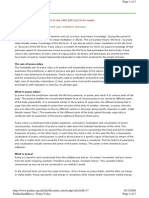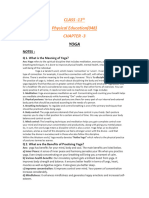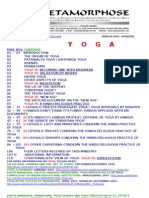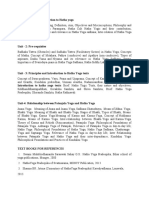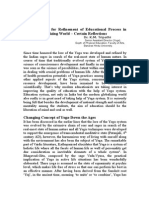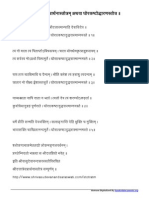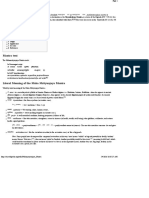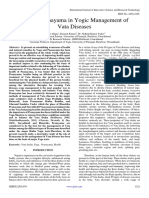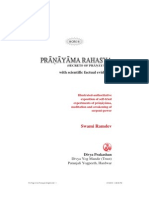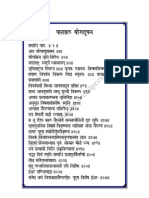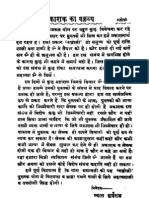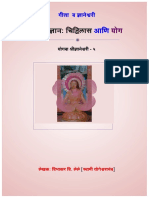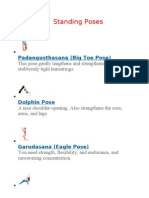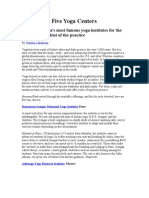Ashtanga Yogaa
Ashtanga Yogaa
Uploaded by
spirit571Copyright:
Available Formats
Ashtanga Yogaa
Ashtanga Yogaa
Uploaded by
spirit571Original Description:
Original Title
Copyright
Available Formats
Share this document
Did you find this document useful?
Is this content inappropriate?
Copyright:
Available Formats
Ashtanga Yogaa
Ashtanga Yogaa
Uploaded by
spirit571Copyright:
Available Formats
Ashtaanga Yog
What most of us are familiar with is the 3rd limb, asana practice. There is no
particular order in which the limbs need to be practiced. Through the practice
of any of the limbs, the others are developed.
In the Yoga Sutras Patanjali defines yoga as Yogas citta vrtti nirodahah (YS
1:2) yoga is the cessation of the fluctuations of consciousness or the stilling of
the mind. The following sutra (YS 1:3) describes what happens next tadah
drastuh svarupe avastanam then the inner being stands revealed in its true
form.
The practice of ashtanga yoga emphasizes developing breath awareness as the
primary means of stabilizing our mind. Ujjayi breathing provides a simple but
powerful technique for cultivating mindfulness of breath and the capacity for
listening. Vinyasa expresses a natural relationship between breath and
movement breath naturally initiates movement, and movement naturally
facilitates breath. The application of the bandhas, the energetic lifting,
suggests there is an energetic root of the breath that when attended to has
both a stabilizing and enlightening effect.
All of these techniques nurture the experience of breath as a vehicle of
awareness. The basic quality associated with inhalation is receptivity an
openness to new energy and experience. Exhalation expresses our willingness
to let go of that, which no longer serves us. Symbolically, breathing is the
ability to let go of the past so that we may more fully embrace the present.
Breath also provides fuel for tapas, the process of purification crucial to our
practice. The 2nd chapter of the Yoga Sutras begins tapah svadhyaya ishvara
pranidhanna kriya yogah purification, self-observation, and surrender to
something greater than, are the actions that constitute any spiritual practice,
or yoga. How does the ashtanga practice incorporate these three qualities?
Practice always begins with a prayer of thanks to the guru, the dispeller of
darkness. The guru is the living embodiment of Ishvara, the timeless, Universal
teacher. What is required of us to experience the grace of the guru is a
willingness to express our gratitude for the gift of yoga and an openness to a
deeper level of experience. This is ishvara pranidhana
The practice of asana provides a context for a concentrated and tangible
experience of self-observation. The wide variety of different asana can be seen
as metaphors for the various circumstances we encounter in life. They allow us
the opportunity to practice the application of awareness to the task at hand. In
the process we learn about strengths and weakness, our areas of rigidity and
flexibility, and our ability to breath and pay attention when faced with a
challenging situation. With practice we begin to cultivate a kind of
dispassionate awareness, which helps us to see ourselves more clearly in all
circumstances. This is svadhyaya.
The combination of breath, movement, and focused awareness begins to
generate heat (tapas) within us. Like an alchemical process, the fire of tapas
purifies and softens us, creating an opportunity to penetrate more deeply into
ourselves than we perhaps can under normal circumstances. According to
Patanjali, this heat purifies the senses of perception, (indriyas), and
consequently, we begin to be more discriminating in how we feed our organs of
perception.
The self-discipline entailed in the practice of ashtanga yoga begins to have a
profound effect on the quality of ones inner life. A newfound sense of self
esteem emerges that makes us feel both more connected to ourselves and the
world around us. As we release toxicity (hala hala) we are more able to
embrace unity. The practice of ashtanga yoga is designed to make us receptive
to the spiritual experience of realizing our own divine nature.
Yoga is above all experiential. It is your own experience that will always be
your truest and best teacher
As Pattabhi Jois is fond of saying 99% practice, 1% theory. Do your practice. All
is coming!
Ashtang yoga ends here a part of course
You might also like
- Introduction To YogaDocument14 pagesIntroduction To YogaS1626100% (11)
- Yoga NotesDocument40 pagesYoga Notesdeekshadeewan456No ratings yet
- 11 Physical Education - Yoga-NotesDocument11 pages11 Physical Education - Yoga-NotesAtu Kaushal100% (7)
- Ewens Michelle Yoga Anatomy Physiology and Kinesiology Essay-with-cover-page-V2Document7 pagesEwens Michelle Yoga Anatomy Physiology and Kinesiology Essay-with-cover-page-V2marialejandrNo ratings yet
- Introduction To Yoga PhilosophyDocument33 pagesIntroduction To Yoga PhilosophyRahul Valiyakulangara100% (1)
- Thelema 101 YogaDocument10 pagesThelema 101 YogaLuke.418No ratings yet
- Yoga As A Science of ConsciousnessDocument6 pagesYoga As A Science of ConsciousnessSandeepan Kalita77% (13)
- Yogic Philosophy EssayDocument6 pagesYogic Philosophy EssayCNo ratings yet
- Iyengar Self PracticeDocument12 pagesIyengar Self PracticeJoesmow100% (5)
- 8 Limbs Part 2Document5 pages8 Limbs Part 2Kevin LightNo ratings yet
- Introduction To Yoga Philosphy PDFDocument13 pagesIntroduction To Yoga Philosphy PDFNishant DhimanNo ratings yet
- Introduction To Yoga Philosphy PDFDocument13 pagesIntroduction To Yoga Philosphy PDFNishant DhimanNo ratings yet
- Hatha Yoga Foundation - Course SummaryDocument20 pagesHatha Yoga Foundation - Course SummaryljunnamedNo ratings yet
- Human EnergyDocument4 pagesHuman EnergysriramNo ratings yet
- 3.manual - Ashtanga1 201117 000117Document66 pages3.manual - Ashtanga1 201117 000117sikkasanjana298No ratings yet
- 8 Limbs Part 1Document6 pages8 Limbs Part 1Kevin LightNo ratings yet
- YogaDocument19 pagesYogaTaoshobuddha100% (1)
- 007 AshtangaYoga AsanaDocument5 pages007 AshtangaYoga AsanaJacklynlim LkcNo ratings yet
- Basic Concept of Yoga Philosophyita-2Document6 pagesBasic Concept of Yoga Philosophyita-2Andrea BarraNo ratings yet
- YOGADocument38 pagesYOGADhruv Damree100% (1)
- Ashtanga Vinyasa Yoga: "Yoga Begins With Listening." Richard FreemanDocument4 pagesAshtanga Vinyasa Yoga: "Yoga Begins With Listening." Richard FreemanMariana EllaiNo ratings yet
- Yoga & Lifestyle (1)Document9 pagesYoga & Lifestyle (1)xp.madhumaltighoshNo ratings yet
- Yoga For Beginners: Ashtanga Yoga: The Complete Guide to Master Ashtanga Yoga; Benefits, Essentials, Asanas (with Pictures), Ashtanga Meditation, Common Mistakes, FAQs, and Common MythsFrom EverandYoga For Beginners: Ashtanga Yoga: The Complete Guide to Master Ashtanga Yoga; Benefits, Essentials, Asanas (with Pictures), Ashtanga Meditation, Common Mistakes, FAQs, and Common MythsNo ratings yet
- Study Material YOGA B.Tech I SemesterDocument25 pagesStudy Material YOGA B.Tech I SemesterAditya SasaramNo ratings yet
- The 8 Limbs of Yoga Explained - Ekhart YogaDocument1 pageThe 8 Limbs of Yoga Explained - Ekhart YogasfcsluckykoriNo ratings yet
- Power Yoga: An Individualized Approach to Strength, Grace, and Inner PeaceFrom EverandPower Yoga: An Individualized Approach to Strength, Grace, and Inner PeaceNo ratings yet
- Notes and Thoughts On Spinal Breathing PranayamaDocument4 pagesNotes and Thoughts On Spinal Breathing PranayamaFilipe Rovarotto0% (1)
- MudrasDocument30 pagesMudrasJorge Hegel100% (1)
- Spinal Breathing Pranayama - Journey to Inner Space: AYP Enlightenment Series, #2From EverandSpinal Breathing Pranayama - Journey to Inner Space: AYP Enlightenment Series, #2No ratings yet
- Yoga MudrasDocument15 pagesYoga MudrasneredehangiNo ratings yet
- YogaDocument4 pagesYogarockalecsNo ratings yet
- Yoga: Way of Life What Is Yoga?Document5 pagesYoga: Way of Life What Is Yoga?karishma10No ratings yet
- What Is Nada YogaDocument2 pagesWhat Is Nada YogaMnvMadhvaNo ratings yet
- PRANAYAMA S: PracticeDocument7 pagesPRANAYAMA S: Practicesundar1811No ratings yet
- YYoga and VE Materials 5UNITSDocument72 pagesYYoga and VE Materials 5UNITSGomathi RajendranNo ratings yet
- Yoga of Light: Awaken Chakra Energies through the Triangles of LightFrom EverandYoga of Light: Awaken Chakra Energies through the Triangles of LightNo ratings yet
- 15-Minute Yoga: Health, Well-Being, and Happiness through Daily PracticeFrom Everand15-Minute Yoga: Health, Well-Being, and Happiness through Daily PracticeNo ratings yet
- Model DissertationDocument32 pagesModel DissertationOszlár Kálmán AndrásNo ratings yet
- Teacher Training ManualDocument87 pagesTeacher Training ManualRoberto Soto100% (1)
- Integral YogaDocument5 pagesIntegral Yogaairan IshaNo ratings yet
- Prana VidyaDocument3 pagesPrana Vidyacrownvm100% (1)
- YTTP-Theory Book 495-497-17-32Document16 pagesYTTP-Theory Book 495-497-17-32Sarita Manish GuptaNo ratings yet
- Yoga Therapy For Holistic HealingDocument9 pagesYoga Therapy For Holistic Healingpresario223No ratings yet
- Lesson 12Document33 pagesLesson 12Marykris CamachoNo ratings yet
- Ashtanga Yoga of PatanjaliDocument8 pagesAshtanga Yoga of PatanjaliAVINASH KEDIANo ratings yet
- Pysical Education Chapter - 3 YogaDocument7 pagesPysical Education Chapter - 3 Yogasiege gamerNo ratings yet
- YogaDocument129 pagesYogaFrancis LoboNo ratings yet
- Yoga - A Reverse Journey From Spiritual To Physical With TimeDocument15 pagesYoga - A Reverse Journey From Spiritual To Physical With TimeAjay LochunNo ratings yet
- Bodsphere's+eBook+ +Transcending+the+Self+Document26 pagesBodsphere's+eBook+ +Transcending+the+Self+Valentina ERene SavvaNo ratings yet
- Hata Yoga1Document30 pagesHata Yoga1Pradosh Kumar PanigrahyNo ratings yet
- AsanasDocument11 pagesAsanaskinggoes2110003No ratings yet
- Yogam Is Most Important ServiceDocument15 pagesYogam Is Most Important ServiceUdaya KumarNo ratings yet
- RAJA YOGA - YOGA AS MEDITATION!: By Bestselling author Yogi Shreyananda Natha!From EverandRAJA YOGA - YOGA AS MEDITATION!: By Bestselling author Yogi Shreyananda Natha!No ratings yet
- Fifth Self Study SheetDocument9 pagesFifth Self Study SheetLakshmi DhanarajNo ratings yet
- Bodsphere's+eBook+ ++the+Eight+Limbs+of+Yoga+Document16 pagesBodsphere's+eBook+ ++the+Eight+Limbs+of+Yoga+Juliana LimaNo ratings yet
- Everyday Yoga Meditation: Still Your Mind and Find Inner Peace Through the Transformative Power of Kriya YogaFrom EverandEveryday Yoga Meditation: Still Your Mind and Find Inner Peace Through the Transformative Power of Kriya YogaRating: 5 out of 5 stars5/5 (4)
- 11 Physical Education - Yoga-NotesDocument11 pages11 Physical Education - Yoga-NotesAbhinav Kumar67% (3)
- Yoga Meditation: The Supreme Guide to Self-RealizationFrom EverandYoga Meditation: The Supreme Guide to Self-RealizationRating: 5 out of 5 stars5/5 (4)
- Materia Medica - WitoulkasDocument132 pagesMateria Medica - WitoulkasVeera Balaji Kumar100% (9)
- Changing Concept of Yoga-Down The AgesDocument15 pagesChanging Concept of Yoga-Down The Agesspirit571No ratings yet
- Homeopathy Medicine For All DiseaseDocument66 pagesHomeopathy Medicine For All Diseasesharad7996% (75)
- Crowd-Funding: LI Jing! Lijing@se - Cuhk.edu - HKDocument15 pagesCrowd-Funding: LI Jing! Lijing@se - Cuhk.edu - HKspirit571No ratings yet
- Secrets of Spiritual Sadhana Part 5 6Document7 pagesSecrets of Spiritual Sadhana Part 5 6spirit571100% (1)
- OshoDocument1 pageOshospirit571No ratings yet
- Secrets of Spiritual Sadhana Part 13 14Document5 pagesSecrets of Spiritual Sadhana Part 13 14spirit571100% (1)
- Certificate Course in Yoga (Three Months Course)Document4 pagesCertificate Course in Yoga (Three Months Course)spirit571No ratings yet
- Yoga As A Spiritual PracticeDocument2 pagesYoga As A Spiritual Practicespirit571No ratings yet
- Scope of Yoga For Refinement of Educational Process in Modern Globalizing World - Certain ReflectionsDocument16 pagesScope of Yoga For Refinement of Educational Process in Modern Globalizing World - Certain Reflectionsspirit571No ratings yet
- Wake Up Your Life Energy: Course AcademyDocument2 pagesWake Up Your Life Energy: Course Academyspirit571No ratings yet
- Dattatreya Prarthana Stotram Ghorakashtodharana Stotram Sanskrit PDF File7635Document2 pagesDattatreya Prarthana Stotram Ghorakashtodharana Stotram Sanskrit PDF File7635spirit571No ratings yet
- Dattatreya-Stotram-1 Sanskrit PDF File7645Document2 pagesDattatreya-Stotram-1 Sanskrit PDF File7645spirit571No ratings yet
- The Presence and Actions of Prā A ŚaktiDocument4 pagesThe Presence and Actions of Prā A ŚaktiPradosh Kumar PanigrahyNo ratings yet
- Mahamrityunjaya Mantra - Wikipedia, The Free EncyclopediaDocument3 pagesMahamrityunjaya Mantra - Wikipedia, The Free EncyclopediaSatyendra SinghNo ratings yet
- Om Namah Shivaya My Prayers To The Lotus Feet of Satguru BabajiDocument2 pagesOm Namah Shivaya My Prayers To The Lotus Feet of Satguru Babajivijay kNo ratings yet
- Yoga Sequences To Support The Immune SystemDocument2 pagesYoga Sequences To Support The Immune Systemspiridon_andrei2011100% (1)
- 10 NadisDocument3 pages10 NadisJacob HoyNo ratings yet
- YogaShaastraYoga MudrasDocument6 pagesYogaShaastraYoga MudrasJayalakshmi V RamaduraiNo ratings yet
- Dhayana JyothyDocument37 pagesDhayana JyothyramanareddegdNo ratings yet
- Ashwini Ayurveda: SanskritDocument4 pagesAshwini Ayurveda: Sanskritdrdivish100% (1)
- Dhyanam by P V Krishna Rao PDFDocument92 pagesDhyanam by P V Krishna Rao PDFSuryanarayana ChallaNo ratings yet
- Role of Pranayama in Yogic Management of Vata DiseasesDocument5 pagesRole of Pranayama in Yogic Management of Vata DiseasesInternational Journal of Innovative Science and Research TechnologyNo ratings yet
- 3 Most Powerful PranayamasDocument9 pages3 Most Powerful PranayamasHazel Aikulola GriffithNo ratings yet
- Prå°Nåyåma Rahasya: With Scientific Factual EvidenceDocument4 pagesPrå°Nåyåma Rahasya: With Scientific Factual EvidencefeedbackongoleNo ratings yet
- PE PROJECT OgDocument32 pagesPE PROJECT OgLEGALNo ratings yet
- Yoga Sutra PatanjaliDocument9 pagesYoga Sutra PatanjaliMiswantoNo ratings yet
- Reiki MeditationDocument2 pagesReiki MeditationCourtney Kolb100% (1)
- Vajroli Yoga Rarest Book (Hindi) Pls Read Description N CommentDocument97 pagesVajroli Yoga Rarest Book (Hindi) Pls Read Description N Commentsharath kumar.r100% (10)
- GITA VA DNYANESHWARI 5 - Vishwavijnyan-Chidwilas Ani Yoga PDFDocument129 pagesGITA VA DNYANESHWARI 5 - Vishwavijnyan-Chidwilas Ani Yoga PDFp s panditNo ratings yet
- Hindi Songs 68, 69 SAHAJ YOGINIDocument2 pagesHindi Songs 68, 69 SAHAJ YOGINItanaha100% (1)
- Unit 6Document15 pagesUnit 6RAGHAV DIXITNo ratings yet
- Standing Poses: Padangusthasana (Big Toe Pose)Document8 pagesStanding Poses: Padangusthasana (Big Toe Pose)yogavashistha100% (1)
- India's Top Five Yoga Centers: A Guide To India's Most Famous Yoga Institutes For The Serious Student of The PracticeDocument3 pagesIndia's Top Five Yoga Centers: A Guide To India's Most Famous Yoga Institutes For The Serious Student of The PracticePushpanjali KumarNo ratings yet
- What Is Kundalini Yoga For BeginnersDocument14 pagesWhat Is Kundalini Yoga For Beginnersjotapedro100% (1)
- Times NIE Web Ed Aug 03 2021 Page1 4Document4 pagesTimes NIE Web Ed Aug 03 2021 Page1 4anshj jainNo ratings yet
- Chand Yogini Sadhana PDFDocument6 pagesChand Yogini Sadhana PDFiadhiaNo ratings yet
- 00 WorkbookDocument36 pages00 WorkbookHaris kurtishi67% (3)
- Viyog: Yoga Certification Board (YCB)Document6 pagesViyog: Yoga Certification Board (YCB)Shailaja PatilNo ratings yet
- Lord Shiva Sadhana For WealthDocument2 pagesLord Shiva Sadhana For WealthSneha_vermaaNo ratings yet
- Steps in - Meditation PDFDocument3 pagesSteps in - Meditation PDFlovablesagiNo ratings yet








